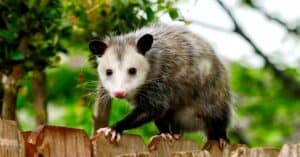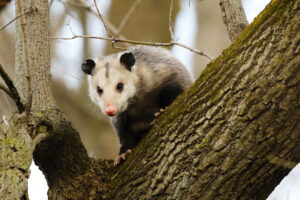Possums (opossums) are omnivorous marsupials native to North America. Often spotted by people because they enjoy our buildings and food waste, possums are viewed as a nuisance pest or a helpful yard assistant, but where do possums nest? Let’s discover whether possums build their own homes or find used spaces and what materials a possum likes to create a cozy home with.

The common brushtail
possum
is native to Australia and the second largest of the possums. Spotted at Botanical Garden, Sydney, Australia.
©Timothy Christianto/Shutterstock.com
Possum vs. Opossums: What’s the Difference?
Opossums and possums are different animals. Virginia opossums live in North America, but possums live in Australasia.
However, most people call Virginia opossums possums for short, it’s the common term. Here’s why the two creatures have the same name.
Opossum is the name early settler John Smith first heard in the 1600s at Jamestown, Virginia. It’s a Native American Powhatan word. Later, when Europeans arrived in Australia, they gave the name to a distantly related similar creature.
For this article, possum refers to the American opossum.
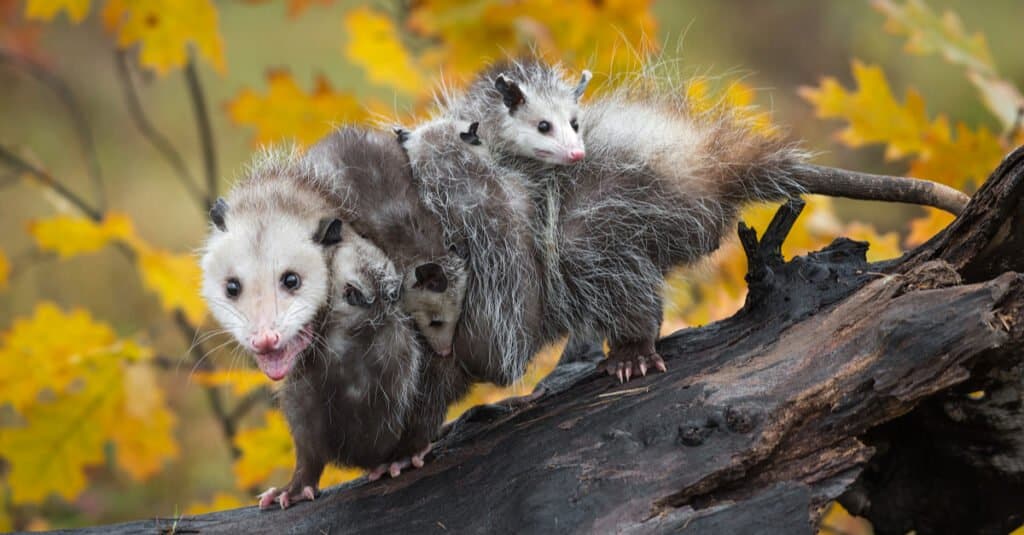
Virginia opossums live in North America.
©Holly Kuchera/Shutterstock.com
Where Do Possums Nest?
Possums do not build bird-type nests in tree branches, instead, they find a sheltered spot that’s dry, quiet, and dark because they don’t like light. Near food and water availability are important too. Here are the main places an opossum will choose to build its nest.
- Other mammals’ abandoned burrows
- Hollow tree stumps
- Wood piles
- Compost heaps
- Caves
- Rock crevices
- Crawl spaces
- Beneath houses, including porches
- Beneath sheds
- Attics
- Outbuildings
- Possum boxes (human-built and erected especially for possums)
These adaptable marsupials are capable survivors that build nests in any safe, dark, and dry spaces they find.
Possums build several nests in different locations so they can move frequently to avoid predators. Other animals that build extra safety nests include squirrels and hedgehogs.
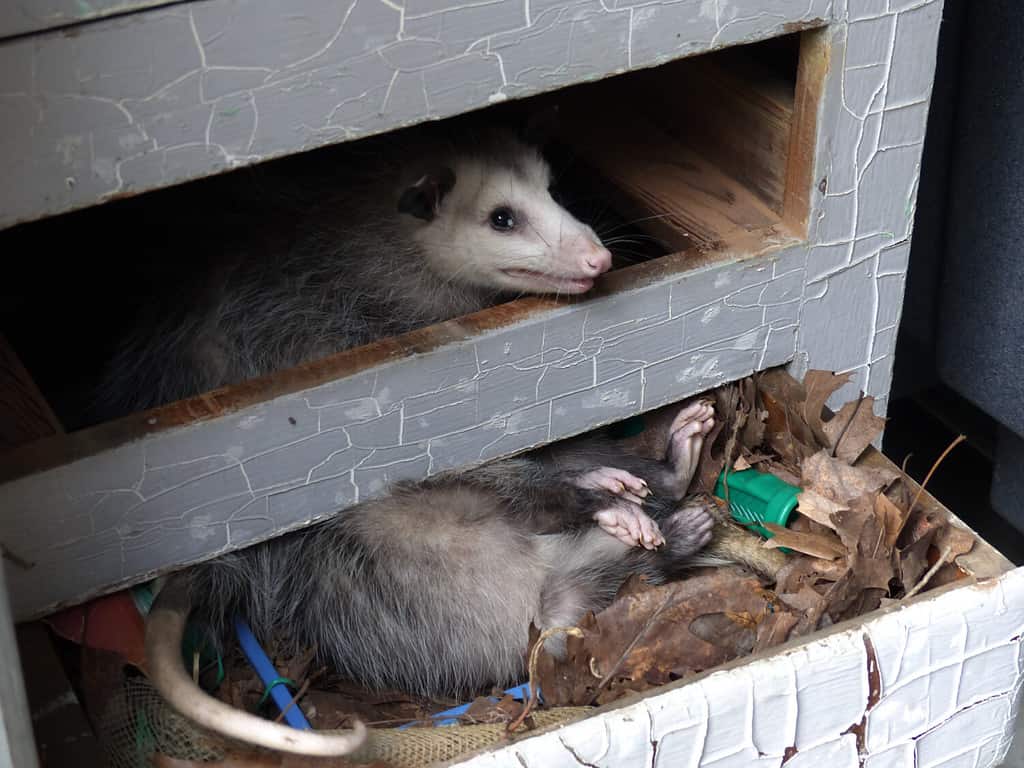
They find a sheltered spot that’s dry, quiet, and dark because they don’t like light.
©Lflorot/Shutterstock.com
Most Popular Possum Nest Sites
As we’ve seen, possum nesting sites are varied, but here are the most popular ones and why they chose them.
Other Mammals’ Burrows
Possums don’t dig or build their structures; they prefer using other animals’ abandoned homes, such as rabbit or groundhog burrows. Burrows are often already sited in a safe space near water, so they’re perfectly suited to possum needs.
Attics
Possums live comfortably near humans, and our attics are very popular possum real estate. It’s because they are dry, dark, warm, and safe from predators.
Barns
Near farmlands, barns are favorite nesting sites because they are dry, warm, and undisturbed. Barns often contain handy nesting materials like straw, hay, and tasty overwintering insects.
Cave and Rock Crevices
Virtually impenetrable caves and rock crevices make safe nest spaces and are highly popular with possums.
Possums build multiple nests and don’t stay in one very long. Typically, a possum stays two to three days in a nest before moving to another nest. It’s a habit that protects them from predators. A possum stays put in a nest only when females have babies. However, a threat will move her on.
What Does a Possum Nest Look Like?
What a possum’s nest looks like depends on its environment. Once a suitable space is located, possums go about the business of collecting material to build a cozy interior. They fill their dens with dried leaves, dried grass, twigs, and bark. Possums even use plastic bags, clothing, and human litter to insulate their nests.
A possum picks up nesting material in its mouth, passes it between their legs, and grabs it with their adaptable tail. Long and flat possum tails can carry numerous twigs, leaves, and pieces of cloth. Both male and female possums build nests this way.
Possums: Species Overview
The Virginia Possum’s scientific name is Didelphis virginianus. It’s North America’s only native marsupial and the only present species. They are members of the Didelphimorphia order and endemic to South America, most likely Amazonia. They spread to North America in the Great American Interchange 3.6–2.6 million years ago.
Opossums are wild animals, but it’s legal to keep one in many U.S. states. The Opossum Society of the United States does not recommend keeping pet possums due to their varied nutritional needs.
Appearance
Distinctive possums are chiefly gray with bright white faces that show up at night. Black ears and pitch-black eyes stand out against their white fur. Possum fur is short and dense, but no fur grows on their pink feet and tails. Opossums use their tails to carry nesting materials and brace their body weight amid tree branches.
Typically, opossums are 13-37 inches long and weigh between 1.7 and 14 lbs. Their size depends on their habitat and diet. In hot tropical areas, possums hit the shorter end of the size scale.
Habitats
Opossums are native to North America, and their range is currently expanding. Their most common habitats are the west coast, midwest, the east, and southern North America. They prefer woodland, forests, and brushy areas close to human habitation. Possums don’t live in desert environments.
Diet
Possums are opportunistic omnivores that will eat pretty much anything they can lay their hands on. Because they have 50 teeth, more than any other North American mammal, they can eat tough foodstuff, including skeletons, to extract the calcium they need.
Insects are their chief food group, but they’ll eat dead animals, including roadkill, eggs, fruit, grains, plants, frogs, snails, and snakes. They scavenge the majority of their diet and often fill up on pet food or the contents of an unsecured trash can. Rifling through trash is one of the main reasons humans view possums as nuisance creatures. They can open trash cans and containers due to their flexible, opposable thumbs.
Snake-eating possums can tackle venomous snakes because they’ve evolved resistance to venom. Possums survive strikes from rattlesnakes and pit vipers, then eat the attacker. It’s not a common skill, but other venom-resistant animals include mongooses and some hedgehog species.
Baby possums nestle inside their mother’s pouch and feed on milk for around 80 days until they’re strong enough to emerge and forage for themselves.
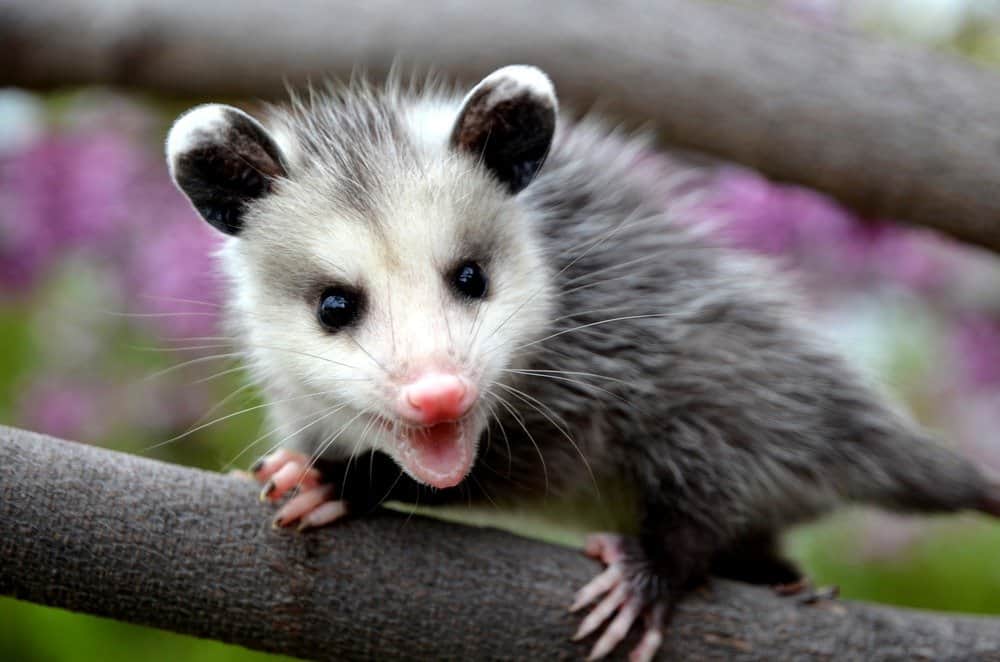
Distinctive possums are chiefly gray with bright white faces that show up on nights.
©rthoma/Shutterstock.com
Behavior
Nocturnal possums emerge at night to find food and mates and build new nests. Although they are solitary creatures, they tolerate another possum’s presence if there’s enough available food and water.
We’ve all heard the term “playing possum” to describe someone playing dead. It comes from possums’ playing dead habit. It’s an involuntary response to danger. Possums “faint” with their teeth bared and eyes closed. Their mouths foam, and foul-smelling liquids from their anal glands put off potential predators. A possum’s stiff body regains consciousness after a few minutes to a few hours.
Predators
Dogs, cats, coyotes, foxes, hawks, and great horned owls prey on possums. Sometimes, humans kill possums on the road or via extermination services.

Nocturnal possums emerge at night to find food and mates and build new nests.
©iStock.com/randimal
When Are Possums Most Active
Possums are nocturnal, so they are most active at night. However, young, inexperienced possums often head out in daylight hours to look for food.
Which U.S. States Have the Most Possums
Possum ranges extend from the east coast to the Atlantic and into the Great Plains. They can’t cope with cold weather because their exposed feet and tails suffer from frostbite. Possums are common in warm states with mild winters, such as Alabama, Texas, and Florida.
Where Do Possums Nest: Recap
Possums are not picky; they nest in a variety of dry, dark places, including attics, caves, other mammals’ burrows, tree hollows, and outbuildings. They don’t dig or build a structure but fill an existing spot with dry leaves, twigs, bark, plastic bags, clothing, and whatever they can carry with their prehensile tails.
The photo featured at the top of this post is © WolfmanSF - Public Domain
Thank you for reading! Have some feedback for us? Contact the AZ Animals editorial team.




